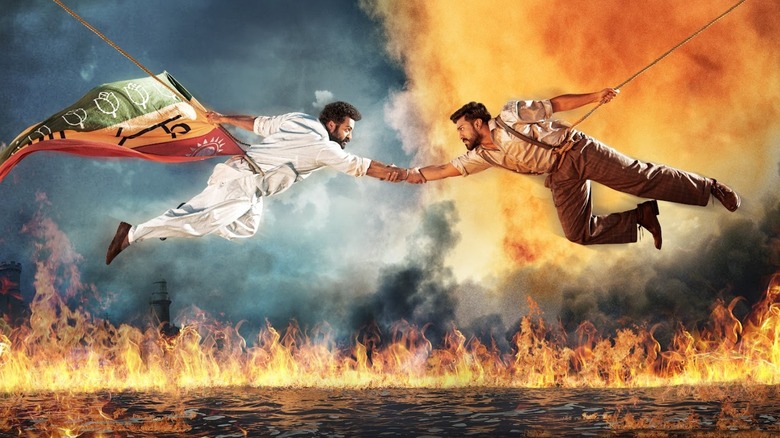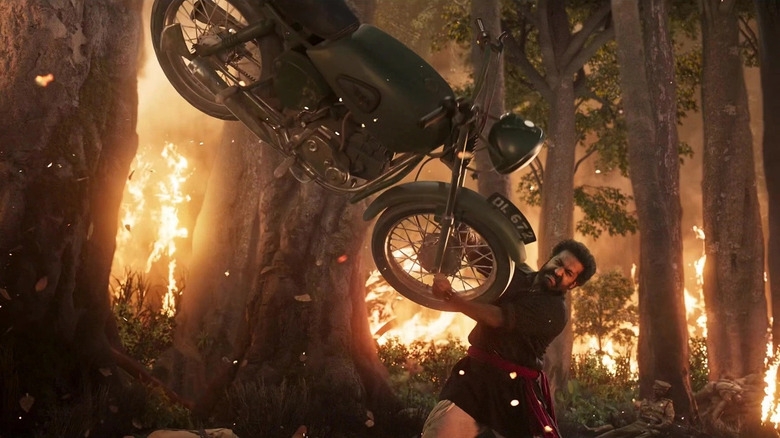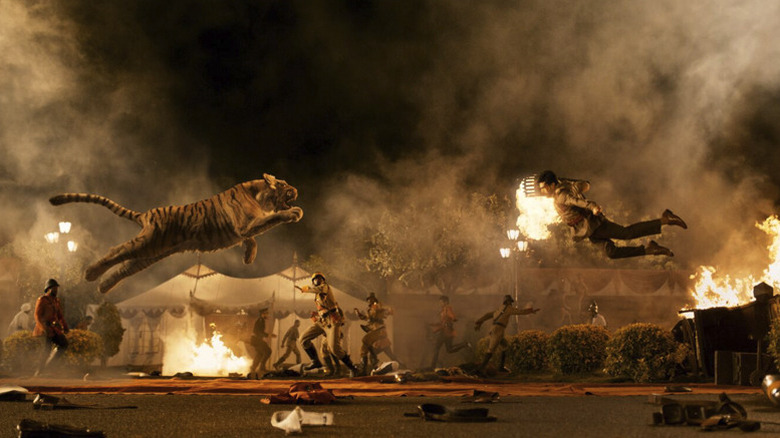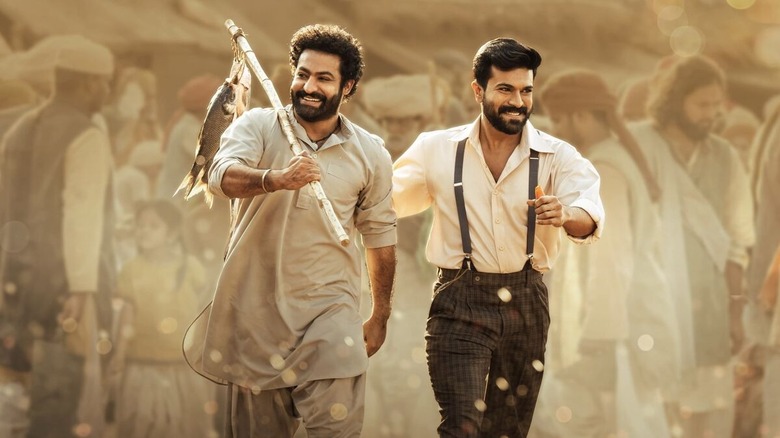RRR Cinematographer KK Senthil Kumar On Shooting The Wildest Blockbuster Of The Year [Exclusive Interview]
I have always been an admitted junkie of blockbuster cinema. Yes, I am absolutely here for your awards season contenders just like the next lover of movies, but even in that realm, I'm more "No Country for Old Men" than "Atonement." Popcorn movies are my thing. It's what gets me out of bed in the morning. All of this to say, I thought I had just about seen it all when it came to this form of entertainment. Then I saw "RRR," and came to understand just how wrong I was.
The Indian blockbuster became a global phenomenon earlier this year, and as a man who saw it in a packed, rowdy theater, I can confidently say it achieved that status with good reason. Director S.S. Rajamouli assembled an absolutely bonkers popcorn movie for the ages that is an action spectacle, a musical (and I hate musicals), a love story, a bromance, and a historical epic, all in one. It's the most densely packed, insane three hour movie you are ever likely to see. So, that raises the question: How the hell did this thing get made? And during a pandemic, no less?
I had the very good fortune of speaking with one of the men that made it happen: cinematographer KK Senthil Kumar. We discussed the extreme challenge of shooting the animal breakout scene at the manor, the challenges of shooting an epic film like this during a pandemic, the joy the team has had seeing the movie becoming a hit around the world, and much more.
'We really worked very hard to get that cinematic image'
I love the movie. I'm a big theatrical experience guy and I got to see it in a packed theater. It was the best thing I've done all year. And I'm not just saying that — it was truly amazing.
No, no, no. This movie is meant to be watched on the big screen. It's good that you went to the theater and saw it. Because we really worked very hard to get that cinematic image and cinematic feel to it. So probably, if you see it on the small screen, you probably would not have experienced it so much. So we designed it in such a way to make it a very big theatrical experience. Did you get a chance to see it in IMAX?
No, not in IMAX, but the theater I was in was sold out, so it was really full, and everyone was really into it. Everyone was cheering and yelling, and it was just the most fun I've had. It seriously was so great.
Thank you. Thanks a lot.
Of course. So one of the things I wanted to talk to you about is this is a three-hour movie, and it's not just a three-hour movie; it's three hours of pure action and pure stuff happening the whole time. So what was it like filming a movie where, not only is it so long, but every scene is just dense, and packed, and kind of crazy?
See, in India, we have movies which are actually 2 hours 15 minutes or 2 hours plus. So generally that is the length of our feature films, and that is why we also have an interval in between, where intermission happens, 1 hour 15 minutes, 1 hour 20 minutes, to give a break. That becomes a very important part [of] what they see before they go out the theater. So interval sequence is very, very important for us. That's where our confrontation between both the heroes happen, which is the highlight of the film. That's why when they go out there, we should see that they also come back to the theater immediately. They rush to the seats.
So that's how it is. That is the thing, all our films are not purely generic. We have all kinds of genres mixed into a film. If you see this will be an action film, it's an emotional drama, it'll have family sentiments, bonding between friends and all. So many genres are mixed. That's how Indian cinema is, generally like that. I have been doing this for the last 20 years or more than 20 years, so shooting this kind of film is really, really fun. I've been really having a great time. We had a really great time working on this film.
Even the previous films before this, I don't know if you know about "Baahubali." So it was all big budget, big stuff, so many things are happening in it. Also with this film, it being one of the most expensive films in India, we wanted to really give a very unique experience to the audience. So it is a very inclusive kind of a thing where I wanted the audience to be engrossed. I was trying to give very visually stimulating images as much as possible.
Well, I think you guys succeeded in that.
'Lots of experimentation was done'
For me, the moment where I realized, "Oh, this is going to be one of those things I think about for the rest of my life," was the moment about halfway through at the manor when all of the animals are let loose. If I'm not mistaken, I heard that took 45 days or nights to shoot? Can you talk a little bit about that sequence?
The sequence took us about 70 odd nights to shoot. Right from the time the truck crashes into the party, till where Bheem is caught by Ram on the terrace. This actually, in India, as I told you, there's an interval sequence. So that becomes a very important sequence in the film that we need to send the audience out on a high so that they come running back to the theater again. And we hired two of India's biggest superstars, Ram Charan [Teja] and N.T Rama Rao Jr. There's a confrontation which is going to happen, so it has to be really something which [the] audience really waits for.
So we have been building up right from the beginning that one person associated is representing water, and other person is representing fire. So when they clash with each other, water is going to do what? [It] is something which the expectations are very, very high. So we need to match the expectations of the audience. That's why we designed literally every shot in that sequence, like how Ram enters the sequence or how Bheem entered the sequence. What happens when they come opposite each other kind of a thing. How fire and water are being used as elements in the fight. All the sequences, the whole fight was designed into small, small, small sequences.
[The] first sequence, how the animals come out of the cages and how the truck is going to smash the gate, and how the animals are going to attack the people. When Ram and Bheem, for the first time, how they come to each other, and now he's going to capture him on top of the terrace. There's so many sequences. It was each equally designed into it, and lots of rehearsals, and lots of test shoots were done for each and every sequence. For this, we had some high points in the fight. So for those high points, we had lots of concept artists working on it who came up with the unique images of what we had in our mind, the director had in his mind.
Based on that, we divided all the shots and how to shoot it, how much of the shot has to be done practically on location, how much of it is going to be in CGI. So those kind of sequences, the planning was done. When the animals are let loose, so there's lots of chaos which is happening and the animals are running between the crowd. Now we need to get the characters to look at the animal, and how they're going to support that, we used a robotic car, small robotic cars, which we placed the figures of animals on it, and it is going between the crowd for the people to understand, a tiger is going up. There's a deer running behind, or a wolf going there.
That is for them to react and other things. So those kind of things were done. Also when the tiger is jumping over a beam before he throws the leopard. So we placed a big LED strip to see the one red light would pass. So for me, as a cinematographer, that is a cue of where the head of the tiger is. So I need to follow it, kind of a thing. Lots of experimentation was done before finally sending it to CGI and fulfilling it.
'That was a bigger challenge than the film itself'
I know the movie took quite a long time and you guys filmed during Covid. How challenging was it to film a movie like this over Covid when you have these massive crowd shots and all these people? It seems like the wrong kind of movie to try to film during a pandemic.
No, luckily one of my favorite sequences in this film is Ram's introduction. Luckily, we just filmed it just before the lockdown, or the pandemic was announced, or came to India. Luckily that was a sequence, because I don't think in other sequences people come so close together and create that kind of claustrophobic feel to it. That was a sequence which I really like and luckily, I'm very happy that we pulled it off before the pandemic. That kind of thing is not possible after the people had their own fears and all.
The interval sequence was shot after the pandemic, but we took all kind of precautions of everyone getting into the set, the temperature was checked, all of them had the vaccination done. All the precautionary measures were taken and everyone, technicians and other things, and even the actors wear masks and only just before the take, they would remove the mask. Though that took us more time because of [the] precautions which we had taken.
That interval sequence where lots of crowd was there, that was actually probably the sequence where I would have used the maximum number of lights ever in my career, because it had so much slow motion and such a big vast area. I had huge 200, 300 feet terrains, with lots of light stuff to give that feel of a party happening. It was a really, really huge sequence to shoot outdoors, actually.
There's a lot of amazing sequences in this film and they're all so different. There's so many different types of movies happening at the same time. Did you have a favorite thing that you shot in the whole movie?
I really love every part of what I shot, but yeah, there are some favorites here and there. So one of my favorite sequences, as I told you, Ram's introduction near the police station. That was a sequence right from the time it was designed and when we were shooting, we wanted to create a very claustrophobic feel. We took the camera inside the crowd. The time of shooting itself, we were actually so happy and overwhelmed. The visuals were looking [like] something which is not seen before.
That was something which was giving us a very big high even when we were shooting that sequence. Because we did "Baahubali," it was actually like living up to the expectations of the audience was a big challenge. So every sequence had to be designed well, and composed, and shot, and lit well, for the audience to appeal. That was a bigger challenge than the film itself.
I've thought about this a lot because this was kind of my introduction to this kind of movie. A lot of Western audiences, people like me, this is very new for them. Have you guys been surprised by the success of the movie in the way that it traveled?
Yeah, it is really surprising for us, actually. We thought our sensibilities of the way we make movies is suited only for Indian audiences, or because "Baahubali" did well in Japan, probably the Eastern side of the world, they might be having the same kind of emotion as Indians. But coming towards the West of India, especially U.S. and Europe, where people really loved it, that came as a real surprise for us.
First one, two persons were tweeting, then suddenly all the writers, critics and all were appreciating the film. I was really overwhelmed with it. We never expected it. Till recently, we were always looking up to Hollywood films for the technicalities and other things, so when people from there appreciate us, it really feels, "Yeah, okay. We have arrived."
My favorite types of movies are big blockbuster action movies, so I see a lot of big visual effects-driven movies. And I've got to tell you, after seeing "RRR," I just hold those movies to a higher standard now, because what you guys did is so tremendous that I just look at other movies now and I go, "You can do better."
The main thing was we were not trying to ape anyone and that, we wanted it to be rooted in India in terms of our culture, we were just taking the technicalities of inspiring, "Okay, this is what they did. No, but how do we do it?" We did not want to deviate anywhere else and we wanted the script and the story to be the thing which has to be presented before, and not [have] the technicalities overtake them. That was the big challenge. Whenever I do [a] film, I always try to think that my job as a cinematographer is to help my director tell his story, rather than my work standing out. It's like, it should be complimenting the film. Finally, if the film is successful and really done well, then as a team we all will be appreciated, and that is what the final goal of the technician's work is.
"RRR" is currently streaming on Netflix in several languages, and on ZEE5 in its original Telugu.



